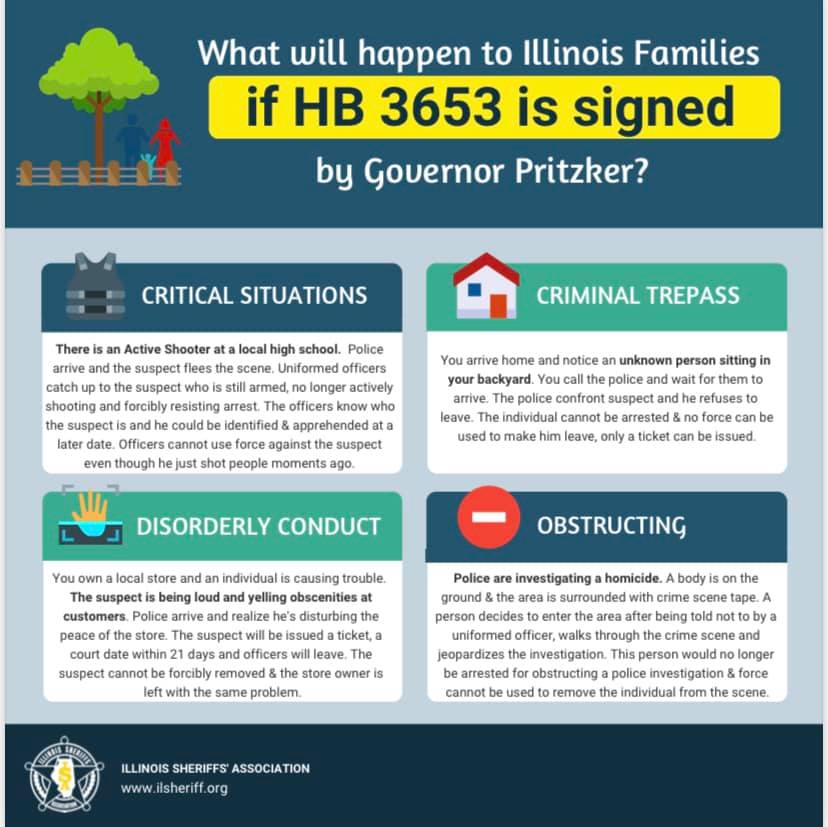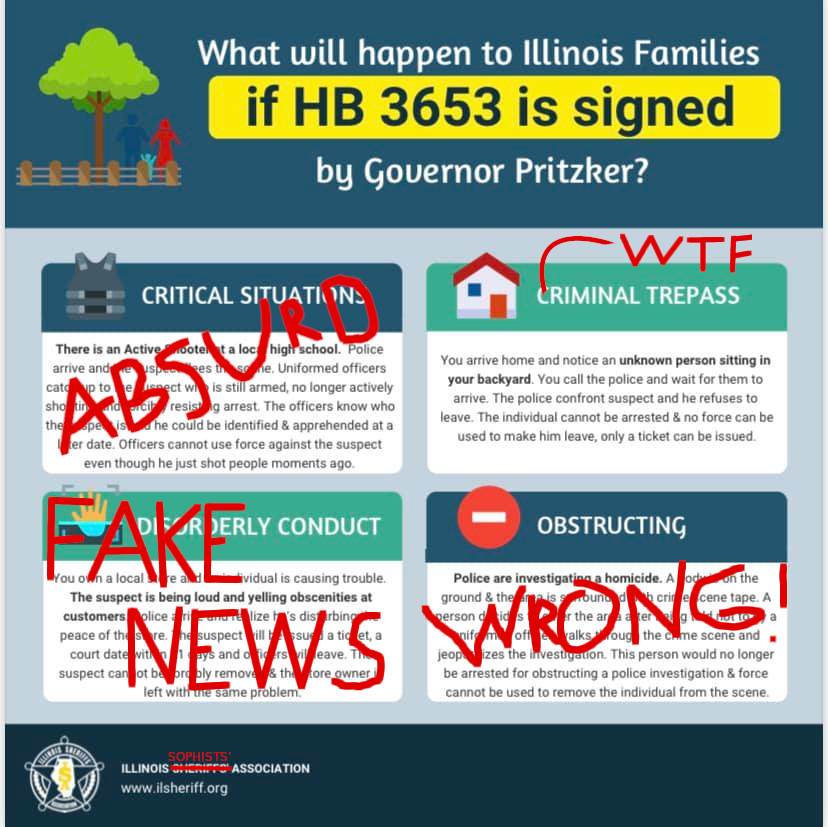2/22/2021
It’s been almost a month and a half since the Illinois Legislature passed HB 3653, a groundbreaking criminal justice reform bill, which includes the Pretrial Fairness Act. State Senator Elgie Sims, a chief sponsor of the legislation, announced on Friday that Governor J.B. Pritzker plans to sign the bill into law today.
Police unions have been unrelenting in their perfidy regarding this bill. Before it was even passed, they made ridiculous assertions like “It’ll make it a crime to be a police officer” or “Prevent officers from using force in almost any situation.” The Illinois Sheriffs Association released this graphic with absurd predictions regarding use of force policies.
Let’s look at them now!

“CRITICAL SITUATIONS: There is an active shooter at a local high school. Police arrive and the suspect flees the scene. Uniformed officers catch up to the suspect who is still armed, no longer actively shooting and forcibly resisting arrest. The officers know who the suspect is and he could be identified & apprehended at a later date. Officers cannot use force against the suspect even though he just shot people moments ago.”
This is almost as absurd as the “it’ll be a crime to be a cop” line. The use of force section in HB 3653 actually states:
“A peace officer, or any person whom he has summoned, need not retreat or desist from efforts to make a lawful arrest because of resistance or threatened resistance to the arrest. He is justified in the use of any force which he reasonably believes, based on the totality of the circumstances, to be necessary to effect the arrest and of any force which he reasonably believes, based on the totality of the circumstances, to be necessary to defend himself or another from bodily harm while making the arrest.”
This is the existing law under 720 Illinois Code 5/7-5, which HB 3653 doesn’t change (except for the addition of the words “based on the totality of circumstances). What HB 3653 actually changes is what situations you can use lethal force. And, even here, it only relates to instances where suspects are fleeing. The bill says an officer can’t use lethal force unless the officer believes the suspect cannot be apprehended at a later date and they are a threat to others. In fact, the bill even says the incident described above actually permits them to use lethal force in instances like:
“The person to be arrested just committed or attempted a forcible felony which involves the infliction or attempting otherwise indicates that he will endanger human life or threatened to infliction of escape use by great of a bodily deadly harm or is weapon, or inflict great bodily harm unless arrested without delay.” (720 ILCS 5/7-5) (282-286)
“CRIMINAL TRESPASS: You arrive home and notice an unknown person sitting in your backyard. You call the police and he refuses to leave. The individual cannot be arrested & no force can be used to make him leave, only a ticket can be issued.”
“DISORDERLY CONDUCT: You own a local store and an individual is causing trouble. The suspect is being loud and yelling obscenities’ at customers. Police arrive and realize he’s disturbing the peace of the store. The suspect will be issued a ticket, a court date within 21 days and officers will leave. The suspect cannot be forcibly removed & the store owner is left with the same problem.”
I’m going to address these two together because they both rely on a faulty interpretation of the same clauses of HB 3653. Criminal Trespassing is a class B misdemeanor, and Disorderly Conduct is a class C misdemeanor. Under HB 3653, Class B & C misdemeanors are eligible for pretrial release. This means if you go in front of a judge for these offenses, there is an expectation you will be released pending trial unless the judge has a really good reason to detain someone. Since these crimes are assumed eligible for pretrial release, the bill also encourages officers to issue summons “in lieu of custodial arrest” for these offenses permitted the individual in question isn’t a danger to anyone. It goes on to say, “A person arrested with or without a warrant for (an offense for which pretrial release may not be denied) may be released by the officer without appearing before a judge.” It uses the word “may” which means it is left up to the discretion of the officer.
So, not only can trespassers & disorderly conductors still be arrested for these offenses, but the bill does nothing to limit a police officer’s ability to legally detain someone and/or escort a suspect to a different location. These sections were added to give police greater discretion in who they arrest, so they have more time to investigate more serious offenses. Why would the ISA be against something that gives them more discretion to make decisions and doesn’t waste time? Because arresting someone takes longer and requires more paper work than just giving them a citation, which means more payable hours & greater need to have more officers hired. Because this means jails get to incarcerate individuals generating all the revenue that goes to jail staff & local counties. This is the true reason police unions are so against these changes, because it might decrease the need for officers thereby potentially reducing union dues.
How would the trespassing situation actually play out? Well, the officer tells the person to leave. They refuse. The officer says I’m going to lawfully detain you and escort you off of this property, then give you a summons to appear in court. The person refuses to be escorted away, i.e., they are obstructing an officer (which is still a class A misdemeanor), i.e., they can still be arrested and taken to jail. Same with the disorderly conduct example.
“OBSTRUCTING: Police are investigating a homicide. A body is on the ground & the area is surrounded with crime scene tape. A person decides to enter the area after being told not to by a uniformed officer, walks through the crime scene and jeopardizes the investigation. This person would no longer be arrested for obstructing a police investigation & force cannot be used to remove the individual from the scene.”
Well, if someone actually did this, they’d be obstructing justice which is a class 4 felony, and which they can still be arrested for. In fact, obstructing justice is one of the offenses that can guarantee a judge will detain a person pending trial.
Another section of the bill the police are misinterpreting is section 720 ILCS 5/31-1 which states you can’t charge an individual for resisting arrest “unless there is an underlying offense for which the person was initially subject to arrest.” Trespassing and disorderly conduct are still offenses, which you can still technically be arrested for and if you resist, you can be charged for that too.
The final propaganda example worth looking at is what happens when in a domestic violence incident. Peoria County Sheriff Brian Asbell told this to HOINews, “So you go to a house and I’ll say its a male female situation and the male is the aggressor. The male says I will fight you or I will resist if you try to arrest me. At that point obviously we know where they live and we know their identity we probably end up knowing where they work through an interview with the spouse or significant other. At that point we have a duty to retreat. Same scenario I’ll go back there the next day to try to conduct the arrest and you run into the same process. I’m not going to go to jail. That’s the problem.”

No, the problem is Asbell is straight up lying. There is no duty to retreat anywhere in the bill. The word retreat is used only twice in the 764 page bill: once, where it says officers “need not retreat to make an arrest” and again, where it defines retreating. That’s it. If anyone is committing domestic battery, it’s a minimum of a Class A misdemeanor. HB 3653 does not change this. In fact, it specifies that domestic battery is one of the few misdemeanors that makes a person eligible for detention pretrial, meaning they have to be arrested and go in front of a judge. Fighting an officer is still considered aggravated battery, a felony. And again, resisting arrest is an arrestable offense. Asbell is going out of his way to deceive people about this bill, and the local media has no interest in actually fact-checking him.
These examples all touch on law enforcement’s absolute unwillingness to allow even the slightest scrutiny of use of force. Use of force is key to the debate around policing. The police are the agents of the state which are empowered to use violence or force to maintain the sovereignty of said state; use of force is literally the police’s defining feature separating them from other government institutions. Despite it being their defining feature, finding an objective measure of how to apply this force is particularly fraught with difficulties. As agents, police apply this force directly, in the moment, based on an individual officer’s discretion meaning the application of force is not only variant but subjective. Despite these hurdles, it is an objective fact that all incidents involving the police do not require the use of deadly force. However, what we’re hearing from the ISA is that unless police are allowed to use deadly force in every situation without scrutiny, then society will crumble. But, that is not a fact; it’s a fantasy.
Don’t believe the hype. Don’t believe the copaganda. Get the facts on HB 3653.

Thank you for your efforts looking into this.
Thanks for your comment. Don’t forget to subscribe!
After my reading of the infographic, snippets of the Bill an other materials, I think only the “Criminal Trespass” scenario (Spelled Trepass in their infographic) seems like it MIGHT be true. Based on the fact they were willing to publish blatant misinformation on other places, I will assume false in totality, until proven true but I’d like to know more.
In your explanation you said it was referring to pre-trial release. The section: 109-1 (a-1) “. . .shall issue a citation in lieu of custodial arrest, . . .Class B and C criminal misdemeanor. . .”
From that wording it seems like the officer is required to issue a ticket and the person never stands before the judge for pre-trial release for that offense
What mechanism allows the officer to require the suspect to vacate the area?
Thanks for your questions. The next section of 109-1 says they may do it. Regardless there are still situations where it is an arrestable offense.
With regards to your second question, the same mechanisms that already exist currently. The law doesn’t change any of that.
Thanks for writing this. It’s always harder to fight a meme than make a meme. So, I appreciate you giving us arguments to use against the police’s knee-jerk reaction to reform. I’m sure we’d get the same level of reaction for even the most trivial reform.
To me, the heart of this bill is basically saying: You can’t commit violence on the public if there’s no underlying crime or serious crime. Also, bail shouldn’t be pre-trial extortion on poor people. If you need to hold someone, get a judge to say so on the merits. You don’t get to use someone’s financial means as a weapon against them.